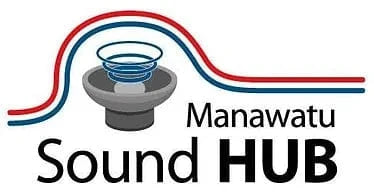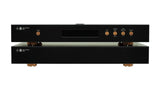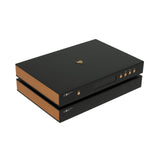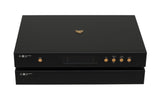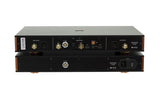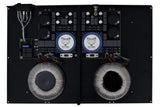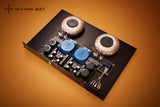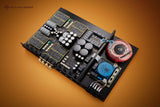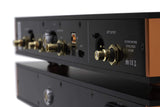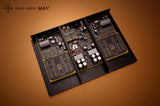The May DAC is here! over 3 years waiting and tremendous R&D to achieve a new level of performance and sound quality that sets a new standard. Ultimate endgame DAC. Natural Analog sound with no compromise. Having the best measurements of NOS R2R Dacs. And delivering our intoxicating sound signature that HoloAudio is known for.
More about the May Dac.
- The new generation of linear compensation technology solves the accuracy errors caused by resistor
tolerance, after compensation, reaching a variance of 0.00005% tolerance accuracy. - Proprietary anti-jitter technology that provides a full amplitude of anti-jitter without increasing noise floor
and other undesirable effects. - Based on this new generation of technology May “梅” can provide a SINAD of >115dB and a dynamic range
of >130dB, which represents the performance limit reached by today’s most advanced R2R architecture
DAC. - Using the ultimate performance of PLL+FIFO technology, provides 0.1Hz Third-Order low-pass ability to
inhibit jitter. It also uses a high-performance femtosecond VCXO as the PLL clock source. Under the premise
of being almost immune to the front-end jitter, it can also lock up to 1.5us-2us @ 1KHz signal with high
jitter. (It can lock up to 1.5us-2us @ 1kHz signal with high jitter on the premise of almost being immune
front-end jitter). - Dual Mono DAC L/R channels are independently powered by their own dedicated transformer in the PSU
chassis. This provides better channel separation and more accurate sound stage. - Official Support USB and I2S up to DSD1024 and PCM1.536MHz sample rate.
- The USB interface uses proprietary firmware with ultra-low latency, a highly reliable data transmission, ideal
USB eye pattern measurements that contributes to 2-4 times higher performance than official firmware. - Two sets of independent HDMI-I2S input interfaces are provided, and each set of I2S has a four-way
independent circuit, as opposed to standard LVDS chip, making I2S clock signals subject to lower
interference and lower jitter. In addition, each group of I2S inputs can be configured with specific pinout
configuration, making it compatible with most of the HDMI-I2S digital devices on the market.
General info:
Dimensions per chassis (2 total): 430 mm (W) * 300 mm (L) * 55 mm (H) additional 12 mm for machined feet (for each part, two of these chassis stacked on each other)
Weight: 18.0 kg Approximately for both Chassis or about 39.68Lbs
Power Consumption: 60W
Product Description:
This new DAC “May” is the design of a new generation, it’s HoloAudio’s finest technology all designed by Jeff Zhu, the engineer behind these great products. It’s a full discrete R2R type of audio decoder and does not have off the shelf-DAC chip! This is a bespoke custom-designed core DUAL MONO DAC modules that are truly a breakthrough with technology for any DAC chip today. The May is here to achieve new heights, new dynamics and simply a full spectrum of audio to please the aural senses.
1. 100VA DUAL O-type(not Toroid) FLATWIRE (NOT roundwire) 6N Copper custom hand made audio transformers. (All models)
2. All copper wire is replaced with 1.5mm pure occ silver wire. Only KTE model
3. Hand Selected Dac modules to have best measurements compared to averages. Higher dynamic range. Only KTE model.
4. CNC Black/Copper shield DAC Module Covers on each module with laser etched KTE logos. Only KTE model.
5. Replaced IEC inlet connectors with pure silver/rhodium plated faston connectors at the IEC inlet Only KTE model.
6. Fuse is upgraded with world class Red Nano fuse with gold/silver and graphene and quartz filtering materials. Only KTE Model
7. Standard Vishay caps are replaced/upgraded with KTE capacitors***
***unique ONLY to MAY KTE – KTE Caps to replace Vishay on the L1/L2
models (we have done extensive testing and these prove to provide intoxicating voicing and are beyond subtle improvements over L1/L2)
8. Custom made HoloAudio 1000V 1uF caps (replaces standard mundorf evo silver/gold caps)
9. Enhanced USB module with Titanis 2.0 circuit
10. Special Kitsune Tuned Edition branding inside and out (pure copper Kitsune fox emblem on top panel) + remote control / KitsuneHiFi VIP service, english support and manuals/software
Note: all models share/include same Flat wire Otype transformers, custom PLL with crystek vcxo clocks, all copper and black chassis color, remote control, dc cable, ac cable. These are the shared features.
HoloAudio is the world’s first to support DSD natively on Resistor Ladder DAC, so far the only one. This is not the DSD converted to PCM before digital-analog converter, but directly by the discrete components of the DSD digital to analog converter. Supported currently on MAC (DOP)and Linux (DOP), and Windows/PC (Direct Native and DOP). Please note, the word ‘R2R’ is the name of a kind of architecture of resistor ladders. This architecture requires less resistors yet still is capable to deliver more than acceptable performance. Most DACs in the industry use this architecture. The DSD Dac module resistor network of May Dac does not use R2R architecture for the DSD, more specifically it uses a very specific architecture which is optimized to perform DSD data to analog. So to be entirely accurate the DSD part of May Dac is using resistor ladders, not R2R..
May’s input and output interface:
- Digital input interface includes
- Enhanced USB (ground isolation) + Titanis 2.0 circuit + KYCON industrial High retention USB Connector (improved impedance spec) – Proprietary inhouse firmware w/ ultra low latency performance. Ultra low noise voltage regulation
- RCA coaxial
- BNC coaxial
- AES/EBU
- optical fiber/Toslink
- I2S (HDMI) – improved ultra high performance 4way custom circuit (NOT traditional LVDS chip anymore) backwards compatible
- I2S-2 (HDMI) – improved ultra high performance 4way custom circuit (NOT traditional LVDS chip anymore) backwards compatible
- All digital input interface supports DSD (DOP mode).
- Analog Output interface: single-ended, balanced.
May DAC R2R structure and design + Input/output Stage
Modern and popular delta-sigma type DAC differs from R2R within one clock analog value can recover a sampling point, and the delta-sigma is used to represent an analog signal after passing through oversampling and high-speed digital switching 0 and 1. In comparison, the conversion structure of R2R is most direct and pure, but delta-sigma is essentially a digital chip, high-speed digital signals 0 and 1 switch to the low-pass filter to process the analog signal and this process is prone to various problems, produce digital sound (digititus) and also in the super-sampling process will inevitably cause some ringing and distortion. But DAC R2R structure requires high-precision resistor network which the cost can be very expensive. And the digital delta-sigma DAC chip in comparison is very low cost. Patented R2R technology. This is the first discrete DAC that has Linear compensation and this allows for ultimate music reproduction accuracy. Dual R2R ladder network with advanced architecture for PCM, and Dual Resistor Ladder network with optimized architecture for DSD!
I/O stages: There is an Op Amp used for input stage and discrete component used for the output stage. The discrete output stage is working in pure class A. It’s BiPolar Junction Transistors, direct coupled.
A common question we get…” Why do you use an Op amp at the input of the DAC?”
The input stage with an opamp is a good choice. It has a paired transistor input by the nature it is manufactured. But an opamp for the output stage is limited due to it’s size and the thermal capability. Also, no one will offer an opamp with class A output as it’s efficiency is so low. So an opamp used as input and discrete output combined together will have an advantage. It doesn’t mean that all discrete is not good. Actually, if we need to achieve enough low distortion. It needs at least 30-40 transistors. Which not only will it be huge and waste of space but it will also be too costly. I mean, to beat the opamp’s performance, a simple discrete architecture is not possible, although an all discrete design looks beautiful.
We use opamp+discrete architecture for the amp parts of May. Opamp is used for the input stage, discrete is used for the output stage. All the transistors in the opamp are in the same die, then it is matched by nature. This is key because by now, there are few choice for low noise matched pair transistors but an opamp has plenty of them inside. The Output stage is discrete because it generates a bit of heat. We need a class A output stage. So you can see May is very hot compared to other DACs. An opamp output simply can’t handle that power.
The true balanced DUAL MONO circuit design
XLR is using all of the circuit and RCA is just using half of them. The balanced output has better performance (THD, noise) and also better common mode rejection rate. If you’re listening environment contains interference, either from AC power or from EMI/RF then you will find a full balanced system can really help significantly.
With diverse and flexible sampling mode conversion mode
1: NOS mode: has no digital oversampling, the raw data is directly converted to analog. Because digital oversampling will produce time-domain distortions, such as ringing, NOS avoids these problems. Generally NOS mode’s other performance indicators have a significant impact, but the Spring 2 is designed to allow top performance while in NOS mode.
2: OS mode: PCM is over sampled to PCM at a higher frequency, DSD is over sampled to DSD at a higher frequency, and then digital is converted to analog.
3: OS PCM mode: in either PCM or DSD the data will be oversampled to PCM and then digital is converted to analog.
4: OS DSD mode: in either PCM or DSD the data will be oversampled to DSD and then digital is converted to analog.
What are the May’s sound characteristics? :
One of the strong points of the spring is the spatial sounds stage presentation. It’s very wide and precise. It never sounds congested like many DACs. The high end is very detailed and never harsh sounding. It has the R2R goodness that many have come to know and love. R2R has almost a cult like following and this DAC will surely become a sought after DAC. Everything comes effortlessly for this DAC. Bass is layered and textures, quite full and present without ever masking over the sweet mid tones that are produced. One special thing about the May is its amazing voltage regulation circuitry that better than 0.2uV output noise! This along with the FLATWIRO-core transformer helps regulate the purest power which translates to audio clarity and accurate reproduction. It must be heard to appreciate and come to love its sound. If you must have the best and nothing compromised then we would suggest the KTE or Kitsune Tuned Edition.
